
Influencer marketing for apps: What you need to know
Welcome to the eleventh edition of MAMA Boards, an AppsFlyer video project featuring leading mobile marketing experts on camera.
For today’s mini whiteboard master class, we have David Cremades, CMO at From the Bench, one of the biggest sports management game development companies in the world.
With the fierce competition in the mobile landscape, marketers are seeking new and increasingly more unique channels through which to reach their audiences. One of the fastest growing, David takes us through the basics of influencer marketing, including the advantages and disadvantages, and practical tips for getting started. If you’re looking for CPIs potentially as low as $0.003, you don’t want to miss this!
Real experts, real growth. That’s our motto.
Enjoy!
Transcription
Hello everyone, and welcome to another edition of MAMA Boards by AppsFlyer. I’m David Cremades and I’m the CMO of From the Bench. We are a Spanish mobile gaming company specializing in the development of sport management games.
We founded the company in 2008 and since then, we have been working with more than 60 official licenses of football clubs, including Real Madrid, FC Barcelona, Liverpool, AC Milan, PSG, and many others. We are also working with the official license of the NBA.
Today, we want to talk about something that is really trendy in the marketing space – influencer marketing. If you want to know how to get users for your product for less than $0.003, just stayed tuned and you’ll discover how to do that with influencer marketing.
So, let’s get started.
What is influencer marketing?
It is a new form of marketing focused on people that can influence other individuals. Influence is the ability to actually persuade someone to perform an action.
It’s not extremely new, but it has grown significantly in the last few years, doubling since 2014.
Why this increase?
Because there is a fierce competition out there and you need to seek new channels for getting new users to your product.
Types of influencer agreements
Now that we know what influencer marketing is, let’s talk about the different kind of agreements that you could sign with influencers.
In this chart, we can observe three different kinds of agreements. The size of the circles represents the quality of the users. The bigger the circle is, the better the quality. First, we have Shoutouts, in which the influencer just mentions your product with a brief description. It comes at a lower price – they are cheaper. However, the user doesn’t know everything about the product.
Second, we have Gameplay, in which the influencer will spend the time he or she needs to explain all of the advantages and features of your product. It comes at a higher cost for sure, but the user will receive all of the information they need to make a decision about your app. They are the best performing content types from a user-quality point of view.
Last, we have Visibility, which refers to content that focuses more on brand awareness. This is typical for large channels with large audiences, and the prices reflect that.
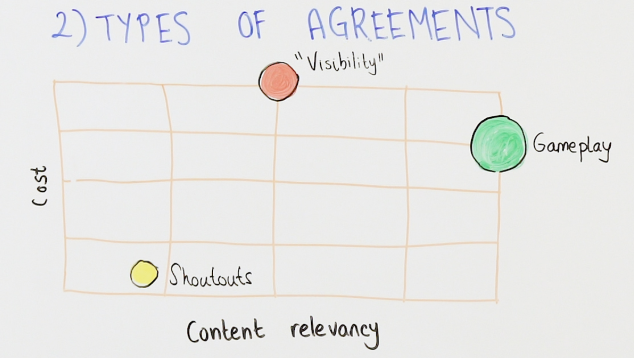
Business models
And how can we pay for an influencer marketing campaign? Well, there are many options out there, but we will focus on the main ones. First, we have a fee, a fixed price. The influencer will charge you a fixed price no matter how the campaign performs. It is the preferred way for the influencer that, many times, is too risky for the advertiser.
Second, we have cost per view or engagement. It is a more fair way of working with an influencer, as they are more involved with the performance of the campaign.
Last, we have cost per install or action. This should be the preferred way for the advertisers, as it implies the benefits of the performance marketing. The problem that the attribution of the install is actually really difficult to achieve in influencer marketing means that few influencers will accept this choice. We will point out some tips to set the price somewhat afterwards.
Micro vs. macro influencers
I would like to clarify at this point a common mistake when thinking about the size of the influencer to work with. It is that working with big influencers is not always the best option. Let’s differentiate between micro influencers and macro influencers.
A micro influencer usually has between 2K and 100K followers. Their posts receive high engagement and they are seen as more authentic, or as people giving their recommendations with more credibility, which leads to higher conversion rates. At the end of the day, working with them comes at lower costs.
Let’s think for a moment about why you follow a pop star. Is it because of his opinion? I don’t think so. And if he talks about a perfume, do you actually believe that he likes the perfume? No, you don’t. That’s the difference with micro influencers. If you decide to follow a non-famous guy talking about, let’s say, a mobile game, for instance, it is because you trust him. You think that his opinion is authentic.
From our experience, micro influencers deliver 50% more engagement. They are 6.2 times more cost-effective and they drive 22% more social buzz.
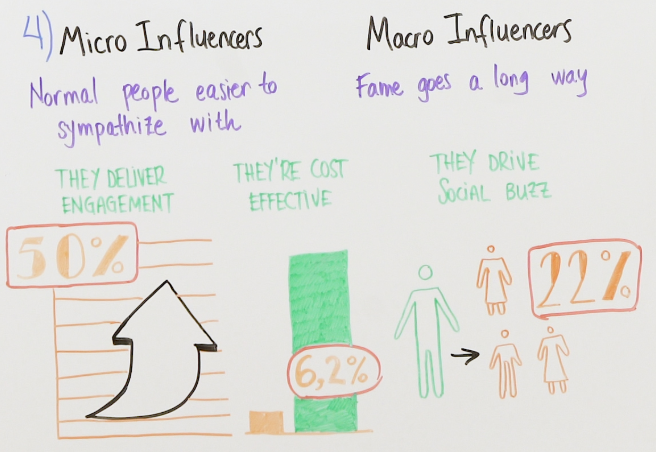
Advantages of influencer marketing
Let’s review some of the main advantages of this new form of marketing.
First of all, lower CPI’s convert to other channels. Yes, we achieved a CPI of $0.003 with an influencer from Latin America on both platforms. It was totally crazy.
Second, you will get high quality users with higher retention rates than the average. This is because the users already knows your app and he trusts the influencer whose saying to him that the app is really good. It’s easy to run economic and quick tests. You don’t need big budgets to know if it can work for you.
As you probably know working with other channels, you will need at least 10K just to optimize. In this case, with 500, it will be more than enough.
Finally, influencer marketing generates downloads over the time, not only on the release day of the post, and that means that the CPI will be continuously dropping over time.
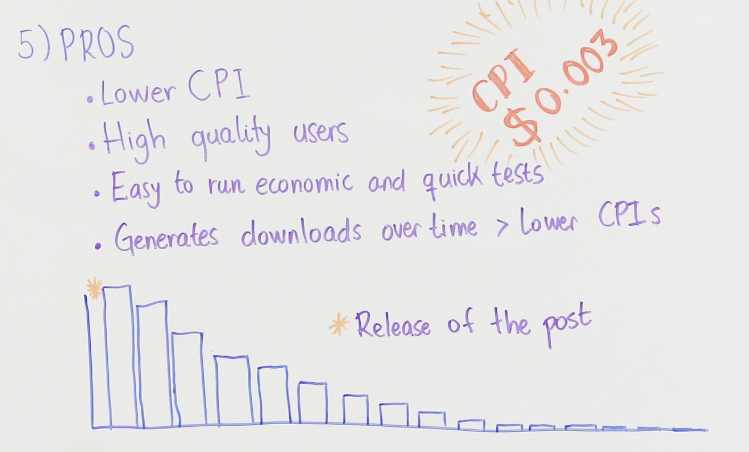
Disadvantages of influencer marketing
In this graph, we can see how a campaign usually works with an influencer. Unfortunately, not all that glitters is gold and there are some main drawbacks as well.
First of all, agreements take too long. It is not as easy as switching on a campaign of Facebook ads, where you simply have to upload the creatives, set your budget, choose your audience, and then just click play. In the case of influencer marketing, you have to deal with real people, which slows down the overall process.
Second, the industry is amateur, which means that there are no price and/or operational standards when negotiating with influencers.
Third, the attribution challenge is also a disadvantage because most of the users won’t download the app through the link provided by the influencers. That means that it is not easy to know how many downloads you have thanks to the campaign. I will explain later on a couple of methods to face this challenge.
Fourth, consider the scale challenge. Finding the right influencer for your campaign is not easy and it is a time consuming process. When you have found one, you have to deal with him and it takes time. This means that, overall, influencer marketing is real difficult to scale.
Finally, it is difficult to predict results. The performance of the campaign will depend on many factors. Some of them are how the audience of the influencer fits your product, how engaging your posts are, and how the influencers are talking about your product, etc. Sometimes you will be pleasantly surprised by the performance and sometimes you won’t.
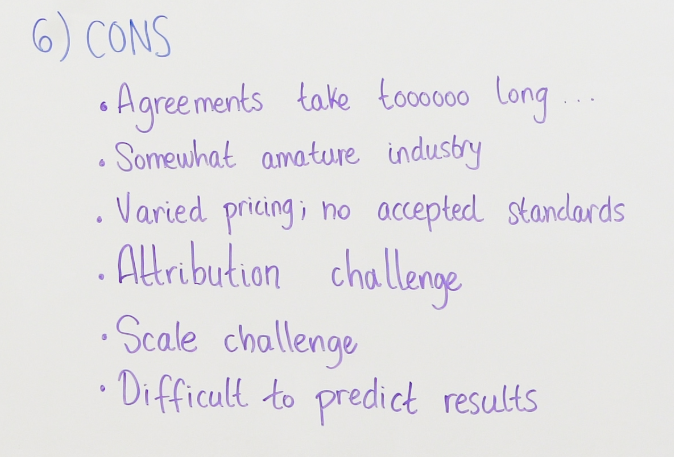
Tips
Now, let me give you some recommendations if you are thinking about starting to work with influencer marketing.
First of all, follower count is irrelevant. You should be more focused on engagement, which is the average number of views by the number of subscribers. You should try to agree on a minimum number of views.
Second, be creative. Users are getting used to this kind of advertising. Therefore, you have to find the best way to, as they say in English, sell without selling. It’s important, also, to let the influencers have creative freedom. They are where they are because of their personality, so let them propose you something.
Last, as promised, let me show you a couple of methods on how to overcome attribution challenge.
First of all, there is the baseline method. For this, you have to calculate a baseline of organic daily downloads. After launching the campaign, you will see a drop of the installs. In this graph, the green part represents the installs coming from the campaign. However, this method is not valid when you are running several campaigns at the same time, which happens much of the time.
The second method is the ratio attribution link method. Let me explain what we did. We choose three or four countries in which we were highly generating downloads. We found some influencers from those countries and gave them one link to measure the installs. After the campaign, we saw an uplift of downloads and we realized that only one of every three installs were attributed. It happened the same in all of the countries.
That link should be placed at the beginning of the description. With that in mind, we can estimate a ratio of three installs between measured and unmeasured. Bear in mind that it is impossible to get 100% accuracy when talking about influencer marketing.
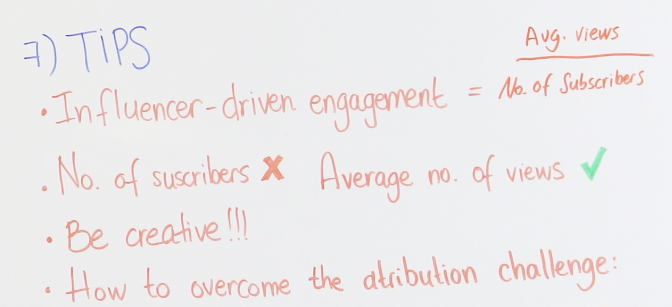
Let’s get practical
It’s time we get practical. What would I recommend you to do tomorrow morning when getting to the office to start working with influencer marketing?
First, set your goals and find the right influencer. Analyze not only the topic of posts but also the relationship that he has with his audience. For that, you can use the comment sections and directly see the credibility that influencer has among his followers. I would also analyze how his audience reacts to branding content.
Second, choose the social media channel to use. If you want to explain your product in detail, I would go for YouTube. If you are looking for something more visual, I would choose Instagram. Snapchat, Twitter, Facebook are also other great options.
Third, decide on how to work with an influencer. There are many ways. We will focus on three. As one option, you can work directly with them. It is cheap, but it is really tedious.
The second option is via marketplace. I would recommend FameBit because it’s quick and easy to test. Last week, I was reading an article talking about Facebook that will be launching an influencer marketplace called Branded Content Matching. With this search engine, the marketer can find the right influencers just by selecting parameters such as age, interest, gender, and many others.
The last way is through an agency, but it is more expensive. On the other hand, they will manage everything on your behalf.
Fourth, prepare a detailed and clear briefing and don’t forget to include all the things that you want to say about your product and your expectations. Try to base your pitch on the individual. Tell the influencer why it is a good opportunity for him and for his audience. Try to tell him why you like his channel. And finally always try to negotiate the price.
The last part is to measure. It should go without saying, but you need to measure the performance of the campaign.
Well, this has been all for today. I hope you enjoyed the content and I wish you the best of luck in your influencer marketing campaigns. If you have any comments or any other tips, just use the comments section below. If you want to watch other MAMA Boards, just visit this link.
Okay, see you soon and take care, folks.



